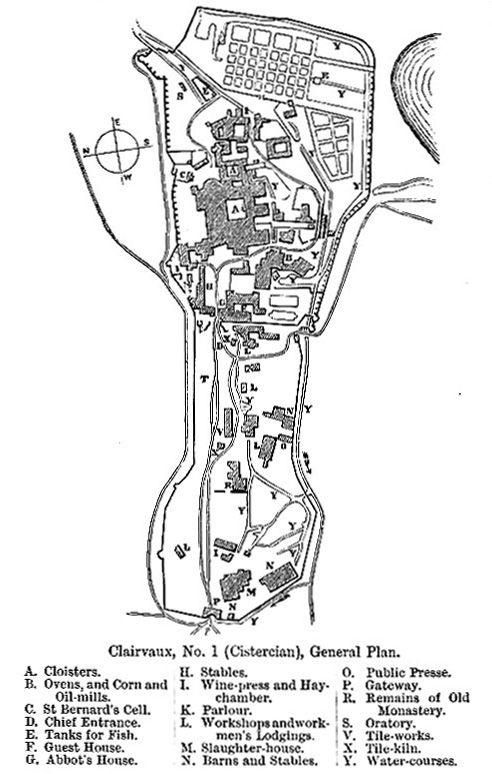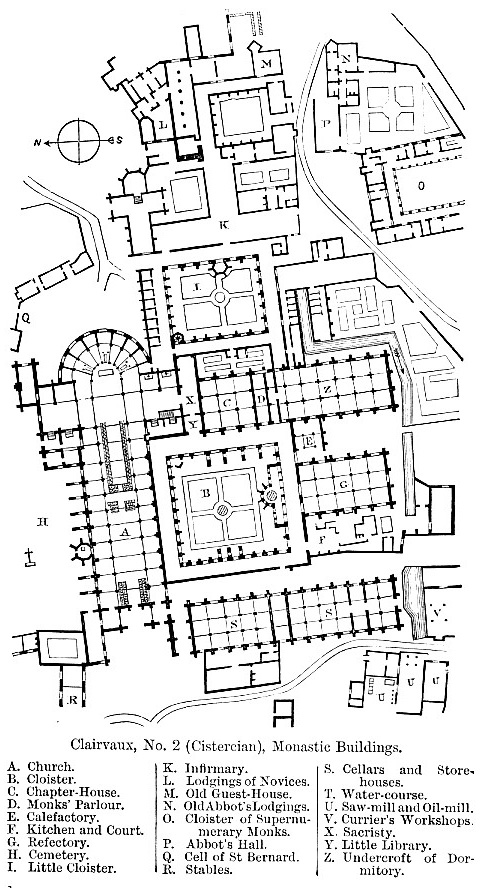1902 Encyclopedia > Abbey > Cistercian Abbeys (cont.): Clairvaux Abbey
Abbey
(Part 11)
(C) Cistercian Abbeys (cont.)
Clairvaux Abbey [Abbey of Clairvaux], France
All Cistercian monasteries, unless the circumstances of the locality forbade it, were arranged according to one plan. The general arrangement and distribution of the various buildings, which went to make up one of these vast establishments, may be gathered from that of St Bernard's own Abbey of Clairvaux, which is here given.

Clairveaux Abbey, No. 1 (Cistercian), General Plan
It will be observed that the abbey precincts are surrounded by a strong wall, furnished at intervals with watch towers and other defensive works. The wall is nearly encircled by a stream of water, artificially diverted from the small rivulets which flow through the precincts, furnishing the establishment with an abundant supply in every part, for the irrigation of the gardens and orchards, the sanitary requirements of the brotherhood, and for the use of the offices and workshops. The precincts are divided across the centre by a wall, running from N. to S., into an outer and inner ward, - the former containing the menial, the latter the monastic buildings. The precincts are entered by a gateway (P), at the extreme western extremity, giving admission to the lower ward. Here the barns, granaries, stables, shambles, workshops, and workmen's lodgings were placed, without any regard to symmetry, convenience being the only consideration. Advancing eastwards, we have before us the wall separating the outer and inner ward, and the gatehouse (D) affording communication between the two. On passing through the gateway, the outer court of the inner ward was entered, with the western facade of the monastic church in front. Immediately on the right of entrance was the abbot's house (G), in close proximity to the guest-house (F). On the other side of the court were the stables, for the accommodation of the horses of the guests and their attendants (H). The church occupied a central position. To the south were the great cloister(A), surrounded by the chief monastic buildings, and further to the east the smaller cloister, opening out of which were the infirmary, novices' lodgings, and quarters for the aged monks. Still further to the east, divided from the monastic buildings by a wall, were the vegetable gardens and orchards, and tank for fish. The large fish-ponds, an indispensable adjunct to any ecclesiastical foundation, on the formation of which the monks lavished extreme care and pains, and which often remain as almost the only visible traces of these vast establishments, were placed outside the abbey walls.

Clairveaux Abbey, No. 2 (Cistercian), Monastic Buildings
The Plan No. 2 furnishes the ichnography of the distinctly monastic buildings on a larger scale. The usually unvarying arrangement of the Cistercian houses allows us to accept this as type of the monasteries of this order. The church (A) is the chief feature. It consists of a vast nave of eleven bays, entered by a narthex, with a transept and short apsidal choir. (It may be remarked that the eastern limb in all unlatered Cistercian churches is remarkably short, and usually square). To the east of each limb of the transept are two square chapels, divided according to Cistercian rule by solid walls. Nine radiating chapels, similarly divided, surround the apse. The stalls of the monks, forming the ritual choir, occupy the four eastern bays of the nave. There was a second range of stalls in the extreme western bays of the nave for the fraters conversi, or lay brothers. To the south of the church, so as to secure as much sun as possible, the cloister was invariably placed, except when local reasons forbade it. Round the cloister (B) were ranged the buildings connected with the monks' daily life. The chapter-house (C) always opened out of the east walk of the cloister in a line with the south transept. In Cistercian houses this was quadrangular, and was divided by pillars and arches into two or three aisles. Between it and the transept we find the sacristy (X), and a small book room (Y), armariolum, where the brothers deposited the volumes borrowed from the library. On the other side of the chapter-house, to the south, is a passage (D) communicating with the courts and buildings beyond. This was sometimes known as the parlour, colloquii locus, the monks having the privilege of conversation here. Here also, when discipline became relaxed, traders, who had the liberty of admission, were allowed to display their goods. Beyond this we often find the calefactorium or day-room-an apartment warmed by flues beneath the pavement, where the brethren, half-frozen during the night offices, betook themselves after the conclusion of lauds, to gain a little warmth, grease their sandals, and get themselves ready for the work of the day. In the plan before us this apartment (E) opens from the south cloister walk, adjoining the refectory. The place usually assigned to it is occupied by the vaulted substructure of the dormitory (Z). The dormitory, as a rule, was placed on the east side of the cloister, running over the calefactory and chapter-house, and joined the south transept, where a flight of steps admitted the brethren into the church for nocturnal services. Opening out of the dormitory was always the necessarium, planned with the greatest regard to health and cleanliness, a water-course invariably running from end to end. The refectory opens out of the south cloister at (G). The position of the refectory is usually a marked point of difference between Benedictine and Cistercian abbeys. In the former, as at Canterbury, the refectory ran east and west parallel to the nave of the church, on the side of the cloister furthest removed from it. In the Cistercian monasteries, to keep the noise and sound of dinner still further away from the sacred building, the refectory was built north and south, at right angles to the axis of the church. It was often divided, sometimes into two, sometimes, as here, into three aisles. Outside the refectory door, in the cloister, was the lavatory, where the monks washed their hands at dinner time. The buildings belonging to the material life of the monks lay near the refectory, as far as possible from the church, to the S.W. With a distinct entrance from the outer court was the kitchen court (F), with its buttery, scullery, and larder, and the important adjunct of a stream of running water. Further to the west, projecting beyond the line of the west front of the church, were vast vaulted apartments (SS), serving as cellars and storehouses, above which was the dormitory of the conversi. Detached from these, and separated entirely from the monastic buildings, were various workshops, which convenience required to be banished to the outer precincts, a saw-mill and oil-mill (UU) turned by water, and a currier's shop (V), where the sandals and leathern girdles of the monks were made and repaired.
Returning to the cloister, a vaulted passage admitted to the small cloister (I), opening from the north side of which were eight small cells, assigned to the scribes employed in copying works for the library, which was placed in the upper story, accessible by a turret staircase. To the south of the small cloister a long hall will be noticed. This was a lecture-hall, or rather a hall for the religious disputations customary among the Cistercian. From this cloister opened the infirmary (K), with its hall, chapel, cells, blood-letting house, and other dependencies. At the eastern verge of the vast group of buildings we find the novices' lodgings (L), with a third cloister near the novices' quarters and the original guest-house (M). Detached from the great mass of the monastic edifices was the original abbot's house (N), with its dining-hall (P). Closely adjoining to this, so that the eye of the father of the whole establishment should be constantly over those who stood the most in need of his watchful care, - those who were training for the monastic life, and those who had worn themselves out in its duties,-was a fourth cloister (O), with annexed buildings, devoted to the aged and infirm members of the establishment. The cemetery, the last resting-place of the brethren, lay to the north side of the nave of the church (H).
It will be seen that the arrangement of a Cistercian monastery was in accordance with a clearly defined system, and admirably adapted to its purpose.
The base court nearest to the outer wall contained the buildings belonging to the functions of the body as agriculturalists and employers of labour. Advancing into the inner court, the buildings devoted to hospitality are found close to the entrance; while those connected with the supply of the material wants of the brethren,-the kitchen, cellars, &c., - form a court of themselves outside the cloister, and quite detached from the church. The church refectory, dormitory, and other buildings belonging to the professional life of the brethren, surround the great cloister. The small cloister beyond, with itsscribes cells, library, hall for disputations, &c., is the centre of the literary life of the community. The requirements of sickness and old age are carefully provided for in the infirmary cloister, and that for the aged and infirm members of the establishment. The same group contains the quarters of the novices.
Read the rest of this article:
Abbey - Table of Contents
|

